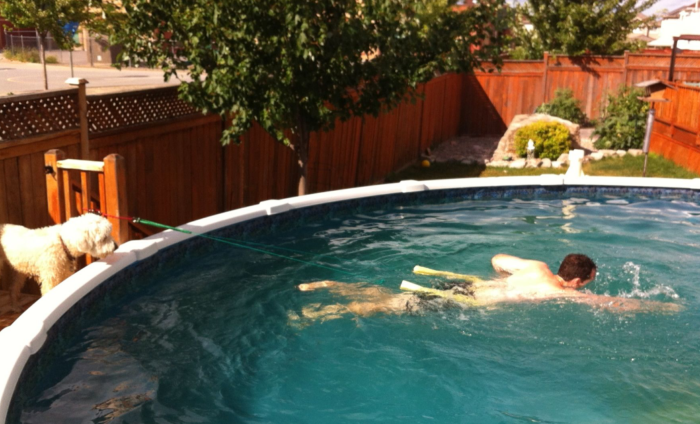
Tethered swimming – how to train for the open water in your back garden
With local pools shut and no access to the open water you might think you have no swimming options beyond splashing about in your bath. But a garden pool is not as expensive as you might think and will allow you to train using a swim belt, bungee or tether. It’s very effective and actually a great workout. See below for some pool options available online for delivery.
Training with a swim belt or tether can increase speed, improve technique and endurance for an overall stronger open water swim. Whether it is practising bilateral breathing, kicking or sighting, a swim belt/tether should be part of your swim training.
Olympic open water champion Sharon van Rouwendaal showing how it’s done!
So, what is a swim tether?
There are two common types of tether, a swim belt or foot tether. A swim belt is a strap that fits around your waist and has an elastic cord attached to a plastic ring at the back. The belt can easily be attached around your waist by an adjustable clip component at each end. Another form of tether is one that attaches to your feet via booties or ankle straps.
I have tried both types and I personally prefer the ones that tether to your feet. They give you great feedback from your feet and whether your legs are splitting during your stroke and causing extra drag. You can also get a sense of your body rotation. Tethered swimming is great to really tune in to what your entire body is doing.
The tethers that go around your waist are also great for all swimming strokes so, if you can, try both. However, the belt types of tether may need attaching higher up to avoid impeding your feet and aiding rotation.
I use a Swimovate Poolmate watch to record my swims when using a tether as other watches may only use GPS – during tethered swimming your GPS watch won’t show good data as you won’t be swimming very far!
The advantages of tethered swimming
Swim belt training can:
- Be used for a variety of sessions including technique, strength and endurance.
- Improve your ability to swim in a straight line instead of weaving from one side to the other.
- Aid in practising bilateral breathing, helping you concentrate on the least amount of head rotation you need to take a breath on each side.
- Improve your kicking by allowing you to concentrate on the motion from your hips and thighs rather than from your knees.
- Enable you to work on sighting, which is something all open water swimmers need to practise. Set up a water bottle or cone on the other side of the pool as something to sight on. Lift your head slightly with your eyes just above the water like “crocodile eyes” and then breath to the side. Try not to breath to the front as your hips will sink low and cause drag.
- Be a good tool for drills, especially one-arm drills. Swim with one arm for a set amount of time, then switch to the other. This drill will help produce a more even stroke. You can also use it with other kit such as paddles and a swim snorkel.
- Help to minimise over-rotation by letting you concentrate on equal rotation for each side.
- Allow you to apply the same pull force with each arm and aid in a full stroke for each arm.
- You can also use your swim tether for water running. Water running is a great way to run with low impact. Ideal for re-hab.
Triathlete Jodie Stimpson taking her training to her back garden
Training session
Below is an example of an open water technique session:
Time: 35 – 40 minutes
EQUIPMENT
Tether, paddles
WARM UP
5 – 10 mins getting used to the tether with easy front crawl (FS)
What is your beat kicking? Are you rotating your hips and shoulders? How was your head position? What is your arm extension?
40 strokes with paddles concentrating on hand entry
40 stokes normal FS
40 strokes paddles concentrating on catch and pull phases
20 strokes left arm only, 20 strokes right arm only
MAIN SESSION
5 x 100 strokes with 20s RI
1-minute easy swim
Sighting:
5 x 100 strokes as:
1. 20 sighting every breath (left) + 80 settle into sighting every 2 breaths B2s +30s
2. 20 sighting every breath (right) + 80 settle into sighting every 2 breaths B2s +30s
3. 100 B3s sighting every 2 breaths swap to sight on other breathing side half-way
4. 100 sighting every 5 strokes – breath when you need to
5. 100 sighting every 5 strokes – breath B5’s
Which works best for you?
WARM DOWN
5 minutes easy stroke choice
Set up your own pool
Setting up your back garden pool need not be expensive, here’s an example of what you can get delivered online.
Intex Pool – Metal Frame Rectangular Pool 300 x 200 x 75 cm, £75
Pump and Filter – Intex Krystal Clear Swimming Pool Filter Pump & Cartridge, £50
Solar Heating Mat – Intex Eco-Friendly Solar Heating Mat, £16
Waist Tether – Decathlon (Nabaiji 500 swimming elastic belt), £24
Total: £165
Note: You should also consider a water testing kit and pool cover. Check the depth of your pool to ensure your particular arm stroke is suitable. Depending on where you live you may need to get more mats to raise the temperature more and swim in a wetsuit. Other pools are available.
About the author
Karen Parnell is an IRONMAN Certified Coach and British Triathlon Federation (BTF) Level 3 High Performing Coach and Tutor. She is also a qualified Personal Trainer (AIQ) and ASA Open Water Swimming Coach. Karen is based near Malaga in Southern Spain where she runs ChiliTri coaching and camps. She runs 121 and small group triathlon camps all year round in Spain. Southern Spain is famous for its mountain cycling, sea & lake swimming and trail & beach running.








